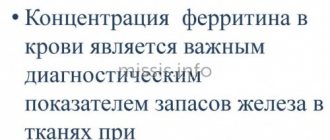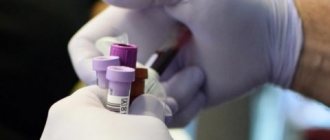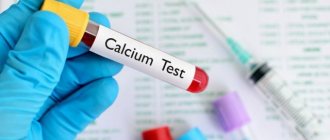October 10, 2021
Anemia is a decrease in hemoglobin content and/or a decrease in the number of red blood cells per unit volume of blood, leading to a decrease in oxygen supply to tissues
What is anemia?
Anemia is a decrease in hemoglobin content and/or a decrease in the number of red blood cells per unit volume of blood, leading to a decrease in the supply of oxygen to tissues. The diagnosis of anemia is made when hemoglobin decreases below 130 g/l in men and below 115 g/l in women.
In children, the age of the child is taken into account when diagnosing anemia. Anemia is classified depending on the cause and mechanisms of occurrence, as well as by color index. The severity depends on the decrease in hemoglobin levels in the blood and is divided into: mild, moderate and severe.
In the initial stages of the disease, a person feels constant fatigue and decreased performance. If you perform a laboratory blood test with these symptoms, it will determine a decrease in the level of hemoglobin and red blood cells. low hemoglobin is a very common ailment that occurs in both adults and children. This phenomenon can develop for a number of reasons and is a serious disease that must be treated. Otherwise, anemia can cause significant damage to health.
Iron absorption
The body's daily need for iron in women is 1.5-2 mg.
In the gastrointestinal tract of a healthy person, only 10% of the total amount of iron eaten with food (1–2 mg) is absorbed. Improve iron absorption: ascorbic acid, fructose, citrates contained in fresh fruit juices, bananas, red beans, cauliflower. Reduce the absorption of iron from food: phosphates, tanning agents, complex polysaccharides, polyphenols, oxalates contained in cereals, eggs, cheese, tea. The effect of tea containing tannin is especially striking: when consumed, the absorption of iron is reduced sixfold (down to 2%). There are two types of iron in foods: heme (organic) and non-heme (inorganic). Heme iron is absorbed most completely. This iron is found in lean meats, fish, and poultry. The absorption of iron from animal products varies from 6% to 22%, while about 1% of iron is absorbed from plant foods. Fats (lard, butter and vegetable oil), soy protein, coffee, and dairy products inhibit the absorption of iron.
The human body contains about 3-4 g of iron, of which 70% is vital, active, 30% is deposited in tissues and 0.1% is transport. The bulk of iron is concentrated in hemoglobin (about 1500-3000 mg). In the depot (ferritin and hemosiderin of internal organs) there is from 500 to 1500 mg, in myoglobin and various respiratory enzymes - no more than 500 mg.
"We live because we breathe..."
...and iron plays a huge role in this, and at the cellular level. The adult body contains an average of 5 grams of iron. Most of it is found in hemoglobin, which transports oxygen to all organs and tissues, up to 10% is in myoglobin, the “oxygen cushion” for skeletal muscles and myocardium. Our body keeps approximately a quarter of the total amount of iron in reserve - in the liver, muscles, spleen, and bone marrow. And 1% of the mineral is contained in special enzymes that ensure the processes of cellular “respiration”. Iron's position is more than privileged. He even has his own personal “taxi” - the protein transferrin, which “carries” the metal directly to the places of use.
Causes of iron deficiency:
1.Increased need of the body for iron during pregnancy
During pregnancy, a woman’s body spends more than 1000 mg of iron. A woman’s need for iron during pregnancy can reach 15-18 mg/day, while outside of pregnancy the daily need is about 2 mg. This leads to a decrease in stored iron in all women by the end of pregnancy. It takes at least 2-3 years to restore iron reserves consumed during pregnancy, childbirth and breastfeeding.
2. Nutritional iron deficiency.
This type of iron deficiency occurs when there is insufficient supply of iron from food: vegetarianism, a passion for diets low in animal proteins. During pregnancy, a vegetarian diet is unacceptable.
- 3. Presence of a pathological background for the development of anemia
- use of intrauterine contraceptives (they increase menstrual blood loss);
- endometriosis
- uterine fibroids
- abnormal uterine bleeding;
- gynecological diseases accompanied by bleeding;
- heavy and prolonged menstruation;
- hypothyroidism and thyroid dysfunction;
- diseases of the gastrointestinal tract (peptic ulcer of the stomach and duodenum, erosive gastritis, nonspecific ulcerative colitis, etc.);
- diseases of the kidneys and urinary tract (chronic pyelonephritis, glomerulonephritis, etc.);
- multiple pregnancies and births (more than three) with an interval between births of less than two years;
- multiple births;
- pregnancy occurring during lactation;
- frequent abortions and spontaneous termination of pregnancy preceding this pregnancy;
- foci of chronic infection.
Features of the course of pregnancy in the early stages
- vomiting of pregnancy;
- bleeding.
- 5. Puberty and growth
- 6. Iron resorption deficiency
This type of anemia is caused by a decrease in the absorption zone of iron during gastritis, duodenitis, enteritis, resection of the stomach and large areas of the small intestine.
Methods for diagnosing anemia
Anemia is diagnosed based on laboratory tests.
General blood analysis
A complete clinical blood test is the basic test for determining anemia. For a more detailed diagnosis of certain types of anemia, additional studies may be prescribed.
More information about the diagnostic method
Sign up for diagnostics To accurately diagnose the disease, make an appointment with specialists from the Family Doctor network.
Complications of pregnancy with iron deficiency anemia
Anemia in pregnant women is a pathological background that contributes to the development of a number of complications of pregnancy and childbirth.
- Premature abruption of a normally located placenta, anomalies of labor.
- Increased blood loss during childbirth and bleeding - in 10% of women.
- In 8–12% of cases, the postpartum period is complicated by purulent-septic diseases and uterine subinvolution.
- A lactation disorder was detected, and both quantitative and qualitative changes in breast milk were observed.
- Adverse effects on the condition of the fetus: contributes to the development of fetal growth retardation syndrome, chronic fetal hypoxia.
- A decrease in adaptation of newborns in the early neonatal period is recorded in half of the cases.
Anemia Treatment Methods
Treatment of anemia is aimed, first of all, at identifying and eliminating the cause of the disease. In case of detected iron deficiency (vitamin B12, folic acid), replacement therapy is carried out with drugs that compensate for this type of deficiency. A special diet high in essential substances is also prescribed.
Doctor visit
If you are concerned about weakness, dizziness, drowsiness and other symptoms that suggest anemia, we recommend that you consult a general practitioner or family doctor at any of the clinics of JSC “Family Doctor”. The high professionalism of our specialists and modern equipment allow us to effectively treat anemia, including during pregnancy, breastfeeding and other periods that require a special approach.
Make an appointment Do not self-medicate. Contact our specialists who will correctly diagnose and prescribe treatment.
Rate how useful the material was
thank you for rating
Manifestations of iron deficiency anemia
Manifestations of anemia consist of 2 main syndromes: sideropenic and general anemic.
Sideropenic syndrome manifests itself:
- Seizures in the corners of the mouth;
- Glossitis - characterized by a feeling of pain, distension in the tongue, redness of its tip, and subsequently atrophy of the papillae;
- Inflammation of the red border of the lips;
- Dystrophic changes in the skin and its appendages (dry and pale skin, premature wrinkles, brittle nails and hair, the appearance of small cracks);
- Difficulty and painful swallowing of dense foods;
- Muscle weakness;
- Perversion of taste (there is a desire to eat inedible objects - chalk, tooth powder, coal, clay, sand, raw dough, minced meat);
- Perversion of the sense of smell (attraction to the smells of gasoline, kerosene, acetone, varnish, paints, dampness);
- Blue sclera syndrome;
- A pronounced predisposition to acute respiratory viral infections and other infectious and inflammatory processes.
General anemic syndrome manifests itself when the level of hemoglobin and red blood cells decreases.
Laboratory check: not just hemoglobin!
The hemoglobin level, of course, is a very important indicator, but it must be remembered that its norm does not exclude the presence of the latent (hidden) iron deficiency we have already mentioned - a condition in which the metal reserves in the body are already depleted. That is why today, for a more accurate diagnosis of an iron deficiency state, in addition to hemoglobin and the number of red blood cells, a whole range of laboratory indicators is used: ferritin and serum iron levels, iron-binding capacity of serum, transferrin saturation with iron, morphological assessment of red blood cells, etc. A full check will help the specialist dot the i's. . If there is a severe lack of iron and anemia, it is necessary to conduct an urgent comprehensive examination to identify possible health problems that are causing it.
Readily Available Iron 18 mg, 60 Capsules, Nature's Bounty
925 ₽
Dietary supplement NOT A MEDICINE
Its manifestations:
- Pale, slight yellowness of the hands and nasolabial triangle;
- Shortness of breath, increased heart rate, fainting (especially with a rapid transition from a horizontal to a vertical position);
- Palpitations, chest pain;
- Increased fatigue;
- Weakness, dizziness, flashing “spots” before the eyes, drowsiness during the day and insomnia at night, impaired concentration, decreased memory, performance, irritability, tearfulness;
- Loss of appetite, nausea, flatulence;
- Swelling of the face in the morning.
Patients often get used to their condition, regarding it as overwork, stress, etc.
Classification of anemia by severity
The severity of anemia, determined by blood parameters depending on the age and gender of the patient, is conventionally divided into mild, moderate and severe. The mild form is characterized by a decrease in hemoglobin concentration to 90 g/l (the patient may experience general weakness and increased fatigue). The average degree is determined by the range from 70 to 90 g/l (patients complain of shortness of breath, tachycardia, headache, sleep disturbance, tinnitus, loss of appetite), and severe - below the limit of 70 g/l (the main danger of this condition is the development heart failure).
Classification of anemia by color index
The color index determines the level of saturation of red blood cells with hemoglobin. It is calculated during a laboratory blood test using a special formula. Depending on the results obtained, there are:
What is the danger of long-term anemia?
Even mild anemia, if persisted for a long time, can cause serious damage to health! Prolonged oxygen starvation of tissues (hypoxia) leads to metabolic disorders, accumulation of toxic metabolic products, and excessive load on life-support organs - the heart, lungs, as well as excretory organs - liver, kidneys.
As a result of chronic hypoxia, sclerotic processes develop in tissues and organs - normal, working tissue is replaced by sclerotic (conditionally “scar”), as a result of which organs begin to gradually lose their function - cardiosclerosis develops with manifestations of heart failure (shortness of breath, edema, decreased exercise tolerance ), heart rhythm disturbances, respiratory failure, the function of the liver, kidneys, blood vessels, endocrine organs, and brain suffers. A person, without noticing it, acquires chronic diseases, loses his ability to work, becomes emotionally labile, depressed, and his immunity decreases. In addition, against the background of chronic anemia, any acute disease, be it a viral infection, tonsillitis, or more serious illnesses, is much more severe, dangerous complications develop much more often due to the fact that there are simply no compensatory capabilities in the body, they are depleted by a long-term hypoxic state.
In order to avoid the development of chronic diseases against the background of anemia, long-term, debilitating, and sometimes expensive treatments, you must follow simple rules:
- undergo an annual preventive examination - for a healthy person it will be enough to take a general blood and urine test, undergo fluorography and visit a therapist, gynecologist (urologist) and dentist.
- When identifying symptoms of chronic diseases that can lead to the development of anemia, promptly correct them.
- If there are signs of chronic bleeding, promptly diagnose and treat the diseases that cause them.
This is especially true for women with gynecological problems . Often, women are accustomed to enduring all hardships and long, heavy menstruation is considered almost a variant of the norm! This is fundamentally wrong - on the one hand, very often after treatment it is possible to restore the normal menstrual cycle quite easily and there is simply no reason for anemia; on the other hand, long, heavy periods, especially in women after 40 years of age, can be the first symptoms of oncological diseases of the female sphere !
- anemia must be treated! Even if you have mild anemia, it is necessary to promptly correct your hemoglobin level - sometimes just a diet and a monthly course of taking iron supplements are enough to restore normal blood counts and prevent the development of adverse long-term consequences!
At the ACMD-MEDOX clinic, almost all the necessary research methods for diagnosing anemia are available. Comfortable conditions, professional specialists, and modern equipment will allow you to undergo the necessary examinations painlessly and in the shortest possible time.
Experienced doctors at our center will help you identify the first signs of anemia in the early stages, understand the causes of its occurrence and prescribe adequate therapy for the identified pathologies! Be healthy!
Classification of anemia according to the mechanism of development of the pathological process
The following states are distinguished:
Iron-deficiency anemia
– the name indicates the cause of the pathology. Due to a deficiency of an important microelement, hemoglobin synthesis in the body is disrupted. The supply of oxygen to tissue cells, the stability of redox processes, and the functioning of the immune, nervous and cardiovascular systems depend on the level of iron. Clinical manifestations of iron deficiency anemia are dizziness, fainting, weakness and lethargy, shortness of breath with any exertion, palpitations. Pallor of the skin, brittle nails, thinning hair, and cracks in the corners of the lips are also typical for this disease.
Hemolytic anemia
occurs as a result of the accelerated destruction of erythrocytes (red blood cells) and the rapid accumulation of their breakdown products in the body. The main manifestations are an increased amount of indirect bilirubin in the blood. The patient experiences the development of anemic and icteric syndromes with an enlarged spleen and liver, as well as characteristic staining of feces and urine.
Posthemorrhagic anemia
– hematological changes that appear after acute or prolonged chronic blood loss as a result of external or internal bleeding (trauma, heavy menstruation, hemorrhagic diseases, gastrointestinal and pulmonary bleeding). The main manifestations of posthemorrhagic anemia are palpitations, shortness of breath, severe dizziness, darkening of the eyes, and lethargy. In severe cases - loss of consciousness.
Sideroblastic (sideroachrestic) anemia
occurs as a result of a violation of iron synthesis, causing its deficiency in red blood cells. Due to a failure in the processes of getting this microelement into the hemoglobin molecule, iron in the cells is replaced by sideroblasts (red blood cell precursor cells interspersed with iron in the form of a ring). This condition can be congenital or acquired. Experts believe that the main reason for the development of such anemia is a lack of the substance protoporphyrin. This organic component, combining with iron, turns into heme - part of the hemoglobin molecule. The main symptoms of the disease are disturbances in the functioning of the heart and blood vessels, indigestion, pale skin, dizziness, and memory loss. There is a danger of iron accumulation in various organs, which contributes to the occurrence of serious complications (liver cirrhosis, diabetes mellitus).
B12 deficiency anemia
– a disorder of hematopoiesis as a result of a lack of vitamin B12 in the human body. The main reasons for the development of such anemia are lack of adequate nutrition, impaired absorption of B12 due to inflammatory processes in the gastrointestinal tract, alcoholism, and hereditary predisposition. The pathology develops gradually, causing damage to the digestive organs and disturbances in the functioning of the nervous system.
The first signs of anemia in women after 30
Female anemia has certain characteristics of its course. It begins to develop when the hemoglobin level drops to 90-120 g/l. This anemia is considered mild and may not manifest itself in any way. However, if a woman is attentive to her health, then she will still notice minimal signs of a developing disorder.
The first symptoms of anemia in women after 30 include:
- Decreased performance. All those tasks and responsibilities that a woman previously performed will now be difficult for her.
- During the day, sleepiness begins to bother her more and more often, despite the fact that the woman has not changed her daily routine and has enough time to sleep at night.
- Floaters and flashes periodically appear before the eyes.
- When in a cool room, a woman will feel very cold. Such an unexpected reaction to low temperature should lead to the idea of developing anemia.
- The skin of the face becomes dry, wrinkles and cracks appear on it.
- The mucous membranes suffer from ulcerations.
- You definitely need to pay attention to nails that become brittle and dull, and longitudinal stripes may appear on them.
- Anemia affects the condition of the hair. At the age of 30, a woman may find that her hair begins to turn gray and fall out.
- From the mental perspective, changes caused by anemia are more difficult to notice, but most women still note that they have become much more irritable and whiny. There is a weakening of memory and concentration.
The listed symptoms may not develop fully and not always. However, anemia cannot manifest itself completely asymptomatically. The main thing is to listen to your body and not ignore its signals.
Symptoms
IDA can manifest itself differently in different people. In general, this disease is characterized by the development of 2 syndromes: sideropenic and anemic.
Sideropenic syndrome is caused by the occurrence of disturbances in the condition of the skin and mucous membranes against the background of a lack of iron in the body, i.e., a disturbance in the course of metabolic processes. Therefore, with IDA, the following may occur:
- dryness, decreased skin tone, peeling and cracking;
- fragility and separation of nails, the formation of transverse stripes on them, the development of onychodystrophy with flattening or acquisition of a concave shape by the nail;
- cracks and ulcers in the corners of the mouth (cheilitis);
- development of stomatitis (ulceration of the oral mucosa);
- deterioration of hair condition, including loss of shine, hair loss, increased fragility, which leads to split ends;
- disorders of taste preferences with the appearance of a tendency to eat chalk, lime, coal, earth, paint, etc.;
- pathological desire to inhale unpleasant and even downright toxic odors of solvents, paints and varnishes, gasoline, fuel oil, exhaust gases, etc.;
- diseases of the gastrointestinal tract, including damage to the tongue (glossitis, cracking), gums (gingivitis, periodontal disease), teeth (caries), stomach and intestines (enteritis, gastritis);
- unproductive cough, sensation of a foreign body in the throat, difficulty swallowing;
- discomfort during sexual intercourse, increased incidence of infectious urological diseases;
- disruption of the functioning of the sphincters (circular muscles that close the intestines, urethra, etc.), which leads to stress urinary incontinence, for example, when coughing, nocturnal enuresis, etc.
The most characteristic symptom that occurs in most patients with iron deficiency anemia is pale skin. Often it even takes on a greenish tint. In this case, the sclera (whites) of the eyes may become bluish.
Anemic syndrome develops as a result of impaired gas exchange against the background of a drop in hemoglobin levels. Its main manifestations are:
- weakness;
- fast fatiguability;
- the appearance of drowsiness during the day;
- attacks of dizziness;
- loss of consciousness;
- frequent headaches;
- noise in ears;
- flashing spots before the eyes;
- attacks of shortness of breath during physical exertion;
- increased heart rate (tachycardia);
- discomfort in the heart area;
- lowering blood pressure levels.
Sometimes with iron deficiency anemia there is a persistent increase in body temperature to subfebrile levels, and this may be the only symptom of the pathology. While taking iron supplements, the temperature normalizes.
Quite often, the decrease in the level of iron in the body, and therefore the hemoglobin produced, proceeds smoothly. Therefore, many organs and systems manage to adapt to the changed conditions of existence. During this time, the patients’ well-being gradually deteriorates, but since this happens slowly, they do not notice pronounced changes in their condition and attribute the symptoms that appear to overwork. Therefore, often at the moment when they undergo examination or go to the doctor, a severe form of IDA is already observed.








